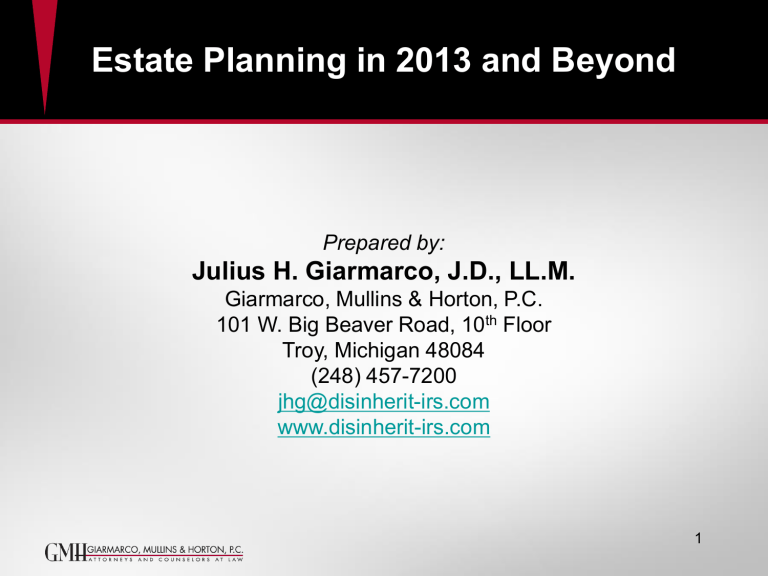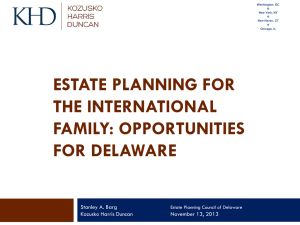Estate Planning in 2013 and Beyond

Estate Planning in 2013 and Beyond
Prepared by:
Julius H. Giarmarco, J.D., LL.M.
Giarmarco, Mullins & Horton, P.C.
101 W. Big Beaver Road, 10 th Floor
Troy, Michigan 48084
(248) 457-7200 jhg@disinherit-irs.com
www.disinherit-irs.com
1
Income Tax Rates for 2013
Single
$200,000+
(AGI)
$250,000+
(AGI)
$398,350+
Taxable Income
Joint
$250,000+
(AGI)
$300,000+
(AGI)**
$398,350+
Trusts
$400,000+ $450,000+ $11,950
Ordinary
Income
33%
35%
39.60%
*Earned income Medicare tax includes 1.45% employer portion
**Phaseout of personal exemptions and itemized deductions begins
Capital
Gains and
Dividends
15%
20%
Medicare Tax
Earned
Income*
Investment
Income
3.80% 3.80%
2
Federal Estate, Gift and GST Tax
Exemptions and Rates
Estate Tax
Gift Tax
GST Tax
Exemption
2012
Rate
$5,120,000 35%
$5,120,000
$5,120,000
*Adjusted annually for inflation.
35%
35%
2013, had Congress failed to act
Exemption Top Rate
$1,000,000 55%
$1,000,000
$1,430,000
55%
55%
2013+ after fiscal cliff rescue
Exemption* Rate
$5,250,000 40%
$5,250,000
$5,250,000
40%
40%
3
Administration’s Proposals that
Didn’t Make it into the 2012 Act
Eliminate a trust’s GST exemption on the trust’s 90 th anniversary.
Eliminate valuation discounts on familycontrolled entities.
Require a minimum 10-year term for
GRATs.
4
Administration’s Proposals that
Didn’t Make it into the 2012 Act
Modify the treatment of “grantor trusts” so that:
• Trust assets would be subject to estate tax.
• Distributions to a beneficiary during the grantor’s lifetime would be subject to a gift tax.
• Trust assets would be subject to gift tax if the trust ceases to be a grantor trust during the grantor’s lifetime.
5
Administration’s Proposals that
Didn’t Make it into the 2012 Act
Caution: Most ILITs are grantor trusts!
• The power to use trust income to benefit the grantor’s spouse (IRC 677(a)(1));
• The power to use income to pay premiums on policies insuring the grantor (IRC 677(a)(3)); or
• The grantor’s non-fiduciary power to substitute trust assets for assets of an equivalent value
(IRC 675(4)(C) and Rev. Rul. 2011-28).
6
GRAT
Planning for Married Couples under
$5.25 Million
7
Planning for Married Couples under
$5.25 Million
Transfer taxes generally irrelevant.
Should an estate tax return (Form 706) be filed at first death to make portability election?
8
Planning for Married Couples under
$5.25 Million
Wills, Living Trusts, General Powers of
Attorney and Patient Advocate
Designations will continue to be needed to:
• Set forth the couple’s dispositive wishes.
• Name guardians for minor children.
• Avoid the costs, delays and publicity associated with probate.
• Make end-of-life decisions.
9
Planning for Married Couples under
$5.25 Million
Preserve step-up in basis at death of each spouse by:
• Leaving assets outright to surviving spouse by joint ownership, beneficiary designation or a simple will.
• Giving surviving spouse a testamentary general power of appointment over assets held in trust.
• Taking steps to cause assets in an irrevocable trust to be included in the Settlor’s (or Settlor’s spouse’s) gross estate.
10
Planning for Married Couples under
$5.25 Million
Trusts will continue to be popular:
• For surviving spouses not capable of managing assets;
• In second marriages with blended families;
• Where the parties fear the surviving spouse may remarry;
• For beneficiaries with disabilities (Special Needs
Trusts); and/or
• For asset protection.
11
Planning for Married Couples under
$5.25 Million
Dealing with the highest income tax rates
(39.6% and 3.8%) that apply to trusts with undistributed income of more than $11,950
(in 2013).
• Invest for growth instead of income.
• Make distributions to move the tax to the beneficiary’s bracket.
• Invest trust property in muni-bonds, annuities and/or life insurance.
12
Planning for Married Couples under
$5.25 Million
Focus shifts to maintaining standard of living.
• Not outliving one’s assets.
• Stretch IRAs.
• Elder Law / Medicaid Planning.
13
Planning for Married Couples under
$5.25 Million
Rethinking traditional planning.
• Portability over credit-shelter trusts.
• Personally-owned life insurance over ILITs.
14
GRAT
Planning for Married Couples in $5-
$10 Million Range
15
Planning for Married Couples in $5-
$10 Million Range
In addition to the planning issues for married couples under $5 million, couples in this range must decide on whether to rely on portability or to use credit shelter trusts.
Portability:
• Now permanent.
• A surviving spouse can use the unused estate tax exemption of his/her last spouse.
• Eliminates the need of a credit shelter trust to take advantage of both spouse’s exemptions.
16
Planning for Married Couples in $5-
$10 Million Range
Situations favoring portability:
• Couples who are more interested in two basis step-ups than removing future appreciation out of their estate.
• A competent spouse who can manage assets.
• A first marriage or no children from prior marriages.
• A desire to avoid increased income tax applicable to trusts.
• A desire not to retitle assets into living trusts and for administrative simplicity.
17
Planning for Married Couples in $5-
$10 Million Range
Situations favoring portability:
• Qualified plans and IRAs are the predominant asset in the estate.
• Creditor protection for surviving spouse is not a concern.
• A desire of the surviving spouse to use the deceased spouse’s exemption to create an intentionally-defective grantor trust for the benefit of children (and more remote descendants).
18
Planning for Married Couples in $5-
$10 Million Range
Situations favoring credit shelter trusts:
• A desire to remove future appreciation from the estate.
• Blended families.
• A desire for professional management, for restricting the surviving spouse’s access to funds and/or for creditor protection.
• A desire to start the statute of limitations on hardto-value assets used to fund the credit shelter trust. May be a low audit risk at first spouse’s death.
19
Planning for Married Couples in $5-
$10 Million Range
Advantages of credit shelter trusts:
• No portability of deceased spouse’s GST exemption.
• The deceased spouse’s unused exemption is lost if the surviving spouse remarries and predeceases his/her next spouse.
20
Optional Credit Shelter Trust –
Disclaimer Trust
Living Trust
First Spouse’s Death
Surviving
Spouse
Everything is left to surviving spouse outright, except what he/she disclaims.
Surviving Spouse’s Death
After second death, all trust assets pass to the couple’s heirs.
Within 9 months time may disclaim
Credit Shelter
Trust
Surviving spouse can receive income and principal for health, education, maintenance and support; plus a 5% annual withdrawal right.
Heirs
21
GRAT
Planning for Married Couples above $10 Million
22
Planning for Married Couples above $10 Million
ILITs.
Dynasty Trusts.
Spousal Lifetime Access Trusts (SLATs).
Grantor Retained Annuity Trusts (GRATs).
Intentionally-Defective Grantor Trusts
(IDGTs).
Qualified Personal Residence Trusts
(QPRTs).
23
ILITs
Grantor/
Insured
Crummey Gifts
Dynasty/
ILIT
Premium Payments
Insurance
Company
Allocate GST Exemption Death Benefit
Net Proceeds
Children and
More
Remote
Descendants
24
Switching ILITs
Sale of policy from old ILIT to new ILIT for cash or promissory note.
• If purchase price is at fair market value, then three-year rule of IRC Sec. 2503 does not apply.
• No transfer-for-value if new ILIT is grantor trust.
Rev. Rul. 2007-13.
• No gain on sale if old ILIT is a grantor trust (or if no gain in policy).
25
Dynasty Trusts
Grantor
No transfer tax paid .
Advantages
•Creditor protection
•Divorce protection
•Estate tax protection
•Dispositive plan protection
•Spendthrift protection
•Consolidation of capital
Gift should take advantage of any remaining lifetime gift exclusion and lifetime GST exclusion
No transfer tax paid .
No transfer tax paid .
No transfer tax paid .
Dynasty Trust
Discretionary Distributions to Children for Life
Discretionary Distributions to Grandchildren for Life
Discretionary Distributions to Great-Grandchildren for Life
Future Generations
26
Dynasty Trusts
$1 Million
After-Tax Growth
5.00%
Value of Dynasty
Trust After 90 Years
$80,730,365
Value of Property if
No Trust
$29,062,927
27
SLATs
Grantor
Assets
SLAT
Spouse and children
Spouse is trustee; and spouse and children have access to income and principal; spouse is primary beneficiary
At spouse’s death
Remainder to children and more remote descendants
28
Non-Reciprocal SLATs
If Husband and Wife set up trusts for each other that are similar, then the two trusts may be “uncrossed” and treated for estate tax purposes as if each spouse had created a trust for himself / herself. United States v Grace , 395
US 316 1969.
Gift splitting is generally unavailable with
SLATs.
29
Non-Reciprocal SLATs
Different provisions for distribution of income and principal.
• Sprinkling of income.
• 5% / $5,000 withdrawal power.
• Different limited powers of appointment.
Different assets and amounts.
Different trustees.
Different funding dates.
30
Non-Reciprocal SLATs
If the richer spouse transfers assets to the poorer spouse so that the poorer spouse can establish a SLAT, this might trigger the steptransaction doctrine.
In Holman , 130 T.C. No. 12 and Gross , T.C.
Memo 2008-21 2008, gifts of partnership interests 6 days and 11 days, respectively, after the formation of the partnership were ruled not to be step transactions.
31
GRATs
$1 million of
Securities
GRAT
Grantor
(Age 70)
$520,156 of
Securities
______________________
End of Year 1
Remainder (Projected)
Taxable Gift
Assumed 10% growth
Assumed Section 7520 rate: 1%
$520,156 of
Securities
Actual Asset Transfer $1,000,000
Annuity Payments (Projected) $1,040,312
$117,672
$0.09
$117,672 of
Securities
______________________
End of Year 2
______________________
GRAT Remainder
$117,672
Beneficiaries
32
IDGT Authorities
Sale to a grantor trust is disregarded for income tax purposes. Rev. Rul. 85-13.
Grantor’s payment of trust’s income taxes is not a gift. Rev. Rul. 2004-64.
Power of substitution does not result in adverse estate tax consequences. IRC Sec.
675(4)(c) and Rev. Rul. 2008-22.
Power of substitution over life insurance not an incident of ownership. Rev. Rul. 2011-28.
33
Sale / Loan to IDGT
1.
Gifts $1M
Grantor/
Insured
2.
Sells/Loans
$9M
3.
$9M Note to Grantor
Balloon Payment in 9 Years
IDGT
5.
Excess Cash
Flow/Premiums
6.
Death Proceeds
(Income and Estate
Tax Free/Leverages
GST Exemption)
Life Insurance
Company
4.
$78,300 annual interest
(Interest Rate 0.87%)
Advantages :
Value of loan proceeds frozen at 0.87% for nine years (January 2013 mid-term AFR).
Grantor’s estate further reduced by the income taxes paid on behalf of the trust.
The trust property escapes estate taxation for as long as permitted under state law.
Possible valuation discounts for promissory note in Grantor’s estate.
34
Grantor Trust vs. Non-Grantor Trust
Year
1
8
9
6
7
2
3
4
5
10
NON-GRANTOR TRUST
Beginning
Balance
Taxable
Income
7%
Less:
Taxes at
40%
Ending
Balance
$10,000,000 $700,000 $(280,000) $10,420,000
10,420,000
10,857,640
11,313,661
11,788,835
12,283,966
12,799,892
13,337,488
13,897,662
729,400
760,035
791,956
825,218
859,878
895,992
933,624
972,836
(291,760)
(304,014)
(316,783)
(330,087)
(343,951)
(358,397)
(373,450)
(389,135)
10,857,640
11,313,661
11,788,835
12,283,966
12,799,892
13,337,488
13,897,662
14,481,364
14,481,364 1,013,695 (405,478) 15,089,581
Year
1
8
9
6
7
2
3
4
5
10
GRANTOR TRUST
Beginning
Balance
$10,000,000
Taxable
Income
7%
Less:
Taxes at
40%
Ending
Balance
$700,000 $ $10,700,000
10,700,000
11,449,000
12,250,430
13,107,960
749,000
801,430
857,530
917,557
14,025,517 981,786
15,007,304 1,050,511
16,057,815 1,124,047
17,181,862 1,202,730
-
-
-
-
-
-
-
-
11,449,000
12,250,430
13,107,960
14,025,517
15,007,304
16,057,815
17,181,862
18,384,592
18,384,592 1,286,921 19,671,514
35
IDGT vs. GRAT
With IDGT:
• No mortality risk.
• Can allocate GST exemption to seed gift.
• Mid-term AFR is less than Section 7520 rate.
• Back-loading (i.e., interest only with balloon payment vs. level annuity payment).
• Not a statutory technique.
• Possibility of unintended gift tax, which may be mitigated by using a “defined value” clause.
36
Qualified Personal Residence Trusts
Grantor
Residence
Rent-Free Right of Use of Residence for 15 Years
QPRT
After Expiration of Selected
Term of Years
ASSUMPTIONS:
Grantor’s Age
FMV of Residence
FMV in 15 years at 5% growth
Term of QPRT
70
$2,000,000
$4,157,856
15 Years
RESULTS:
Initial Gift $793,960
FET Savings (40%) $1,345,558
§ 7520 Rate for Jan. ‘13 1%
Grantor
Pays
Rent
Children or ILIT
37
GRAT
Impact of New Tax Act on Life
Insurance
38
Impact of New Tax Act on Life
Insurance
Tax-deferred investments will become increasing popular.
• Permanent life insurance not only provides tax deferral and tax-free access to cash values (via policy loans and withdrawals up to basis), it also provides an income tax free death benefit.
• For conservative investors, the internal rate of return on life insurance is generally quite competitive.
39
Impact of New Tax Act on Life
Insurance
Charitably-inclined individuals will consider donating appreciated securities (rather than cash) to charities to avoid the 23.8% capital gains tax on the appreciation.
• The donor can then use cash to purchase life insurance, which offers tax-free growth and taxfree access to cash values.
• The charitable income tax deduction can help to offset the cost of purchasing the policy.
40
Impact of New Tax Act on Life
Insurance
Charitable remainder trusts will be more attractive to potential donors.
• The charitable income tax deduction can be used to fund a “wealth replacement” trust.
Non-qualified deferred compensation arrangements will be more popular.
• Life insurance remains one of the most efficient methods of “informally” funding a non-qualified deferred compensation plan.
41
Impact of New Tax Act on Life
Insurance
With fewer decedents being subject to estate taxes, an ILIT may be viewed as less costly and complex than the other planning acronyms
(SLATs, GRATs, IDGTs, QPRTs, CLATs, etc.).
The higher gift and estate tax exemption will assist in funding ILITs without the inconvenience of having to use Crummey withdrawal powers.
42
Uses for Life Insurance in Non-
Taxable Estates
Replace lost income.
Wealth replacement in connection with a
CRT.
Estate equalization in connection with a family business.
Creditor protection.
Second marriages and blended families.
43
Uses for Life Insurance in Non-
Taxable Estates
Special needs children.
Annuity arbitrage.
As an alternative to long-term care insurance.
Charitable planning.
Avoiding income taxes on traditional retirement plans.
44







